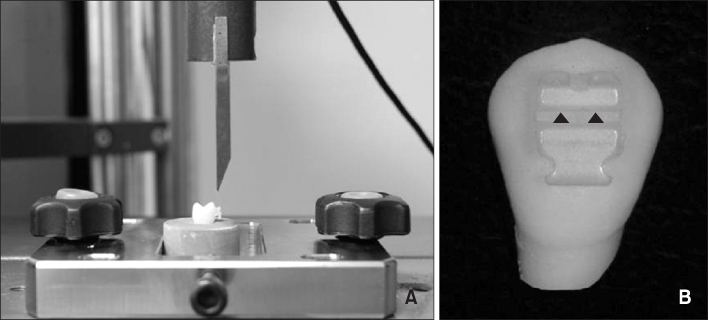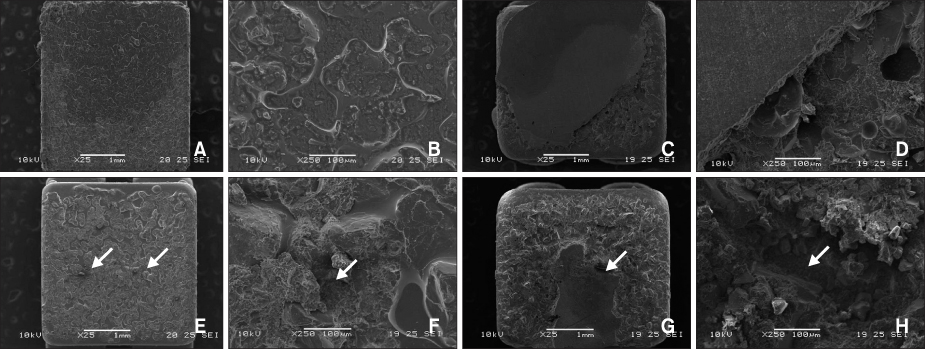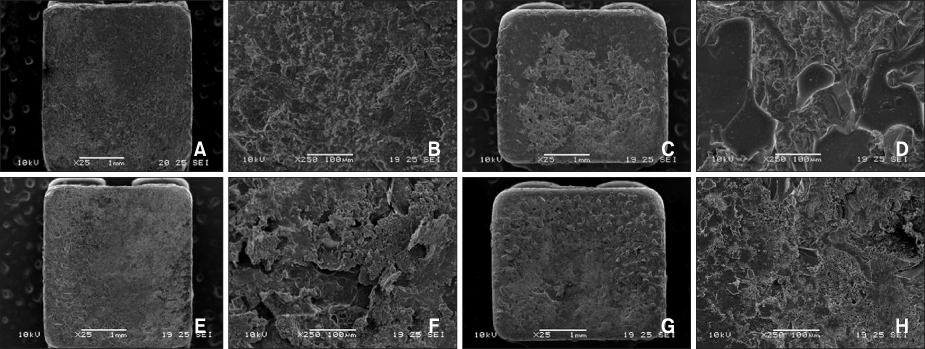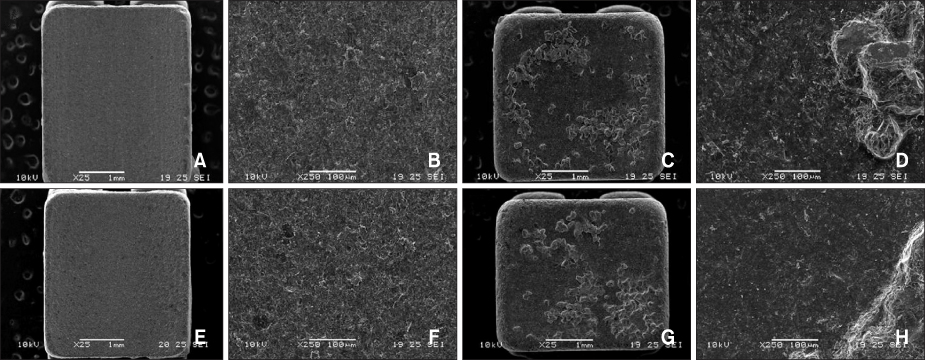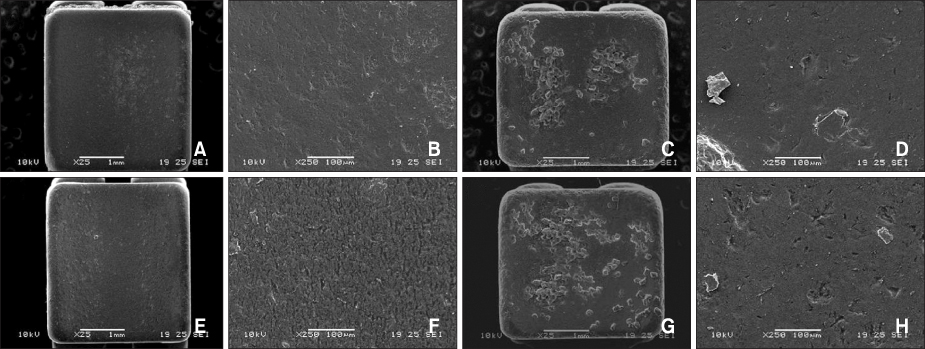Korean J Orthod.
2009 Aug;39(4):234-247. 10.4041/kjod.2009.39.4.234.
Shear bond strength of rebonded ceramic brackets
- Affiliations
-
- 1Department of Orthodontics, School of Dentistry, Wonkwang University, Korea. pigtail@wonkwang.ac.kr
- KMID: 1762579
- DOI: http://doi.org/10.4041/kjod.2009.39.4.234
Abstract
OBJECTIVE
The purpose of this study was to evaluate the shear bond strength of rebonded ceramic brackets according to each condition and find an appropriate method to rebond ceramic brackets with proper shear bond strength in clinical practice. METHODS: The study consisted of 12 experimental groups, according to the types of brackets, debonding methods, and treatment methods of the bracket base. Shear bond strength was measured, and adhesive residues left on the tooth surface were assessed. The base of the bracket was examined under scanning electron microscopy. RESULTS: The shear bond strength of the monocrystalline ceramic bracket group was significantly higher than thatof the polycrystalline bracket group with only sandblasting (p < 0.05). There was no significant difference in shear bond strength between groups that used rebonded brackets which were debonded with shear force and debonded with laser (p > 0.05). The shear bond strength of the sandblasted/silane group was significantly higher than that of the selectively grinded group with a low-speed round bur and the sandblasted only group (p < 0.001). The retentive structure was more presented in groups where laser was applied than in groups where shear force was applied to debond brackets prior to rebonding. The bracket bases which were treated before rebonding presented smoother surfaces than new brackets. CONCLUSIONS: Shear bond strength could be increased by applying a silane coupling agent after sandblasting before rebonding. Also, the bond strength of the selectively grinded group with a low-speed round bur and the sandblasted group showed acceptable bond strength for clinical orthodontic treatment.
Keyword
Figure
Cited by 1 articles
-
Effect of tribochemical silica coating on the shear bond strength of rebonded monocrystalline ceramic brackets
Young-Mi Jeon, Woo-Sung Son, Sang-Wook Kang
Korean J Orthod. 2010;40(3):184-194. doi: 10.4041/kjod.2010.40.3.184.
Reference
-
1. Arici S, Minors C. The force levels required to mechanically debond ceramic brackets: an in vitro comparative study. Eur J Orthod. 2000. 22:327–334.
Article2. Graber TM, Vanarsdall RL, Vig KWL, editors. Orthodontics: current principles and techniques. 2005. St Louis: Elsevier;595.3. Kew KK, Djeng SK. Recycling ceramic brackets. J Clin Orthod. 1990. 24:44–47.4. Yim JB, Lee JW, Cha KS. Shear bond strength of recycled orthodontic brackets treated by variable reconditioning methods. Korean J Orthod. 1996. 26:569–579.5. Shur CH, Choi EA. A comparative study of bond strength of recycled brackets. Korean J Orthod. 1998. 28:641–657.6. Egan FR, Alexander SA, Cartwright GE. Bond strength of rebonded orthodontic brackets. Am J Orthod Dentofacial Orthop. 1996. 109:64–70.
Article7. Chung CH, Fadem BW, Levitt HL, Mante FK. Effects of two adhesion boosters on the shear bond strength of new and rebonded orthodontic brackets. Am J Orthod Dentofacial Orthop. 2000. 118:295–299.
Article8. Bishara SE, Laffoon JF, VonWald L, Warren JJ. The effect of repeated bonding on the shear bond strength of different orthodontic adhesives. Am J Orthod Dentofacial Orthop. 2002. 121:521–525.
Article9. Martina R, Laino A, Cacciafesta V, Cantiello P. Recycling effects on ceramic brackets: a dimensional, weight and shear bond strength analysis. Eur J Orthod. 1997. 19:629–636.
Article10. Buchman DJ. Effects of recycling on metallic direct-bond orthodontic brackets. Am J Orthod. 1980. 77:654–668.
Article11. Harris AM, Joseph VP, Rossouw PE. Shear peel bond strengths of esthetic orthodontic brackets. Am J Orthod Dentofacialial Orthop. 1992. 102:215–219.
Article12. Gaffey PG, Major PW, Glover K, Grace M, Koehler JR. Shear/peel bond strength of repositioned ceramic brackets. Angle Orthod. 1995. 65:351–357.13. Chung CH, Friedman SD, Mante FK. Shear bond strength of rebonded mechanically retentive ceramic brackets. Am J Orthod Dentofacialial Orthop. 2002. 122:282–287.
Article14. Toroglu MS, Yaylali S. Effects of sandblasting and silica coating on the bond strength of rebonded mechanically retentive ceramic brackets. Am J Orthod Dentofacialial Orthop. 2008. 134:181–182.
Article15. Eminkahyagil N, Arman A, Cetinşahin A, Karabulut E. Effect of resin-removal methods on enamel and shear bond strength of rebonded brackets. Angle Orthod. 2006. 76:314–321.16. MacColl GA, Rossouw PE, Titley KC, Yamin C. The relationship between bond strength and orthodontic bracket base surface area with conventional and micro-etched foil-mesh bases. Am J Orthod Dentofacial Orthop. 1998. 113:276–281.
Article17. Reynolds IR. A review of direct bonding. Br J Orthod. 1975. 2:171–178.18. Flores DA, Caruso JM, Scott GE, Jeiroudi MT. The fracture strength of ceramic brackets: a comparative study. Angle Orthod. 1990. 60:269–276.19. Winchester LJ. Bond strengths of five different ceramic brackets: an in vitro study. Eur J Orthod. 1991. 13:293–305.
Article20. Swartz ML. Ceramic brackets. J Clin Orthod. 1988. 22:82–88.21. Bishara SE, Trulove TS. Comparisons of different debonding techniques for ceramic brackets: an in vitro study. Part I. Background and methods. Am J Orthod Dentofacial Orthop. 1990. 98:145–153.
Article22. Rueggeberg FA, Lockwood PE. Thermal debracketing of orthodontic resins. Am J Orthod Dentofacial Orthop. 1990. 98:56–65.
Article23. Bishara SE, Trulove TS. Comparisons of different debonding techniques for ceramic brackets: An in vitro study: Part II. Findings and clinical implications. Am J Orthod Dentofac Orthop. 1990. 98:263–273.
Article24. Boyer DB, Engelhardt G, Bishara SE. Debonding orthodontic ceramic brackets by ultrasonic instrumentation. Am J Orthod Dentofac Orthop. 1995. 108:262–266.
Article25. Strobl K, Bahns TL, Willham L, Bishara SE, Stwalley WC. Laser-aided debonding of orthodontic ceramic brackets. Am J Orthod Dentofacial Orthop. 1992. 101:152–158.
Article26. Mimura H, Deguchi T, Obata A, Yamagishi T, Ito M. Comparison of different bonding materials for laser debonding. Am J Orthod Dentofacial Orthop. 1995. 108:267–273.
Article27. International Standards Organization. ISO/TR 106/SC 1/WG 11. Dentistry: Dental materials - Testing of adhesive to tooth structure. 2003.28. Forsberg CM, Hagberg C. Shear bond strength of ceramic brackets with chemical or mechanical retention. Br J Orthod. 1992. 19:183–189.
Article29. Wang WN, Meng CL, Tarng TH. Bond strength: a comparison between chemical coated and mechanical interlock bases of ceramic and metal brackets. Am J Orthod Dentofacialial Orthop. 1997. 111:374–381.
Article30. Bishara SE. Ceramic brackets and the need to develop national standards. Am J Orthod Dentofacial Orthop. 2000. 117:595–597.
Article31. Bowen RL, Rodriquez MS. Tensile strength and modulus of elasticity of tooth structure and several restorative materials. J Am Dent Assoc. 1962. 64:378–387.
Article32. Calamia JR. Etched porcelain veneers: the current state of art. Quintessence Int. 1985. 16:5–12.33. Lacy AM, LaLuz J, Watanabe LG, Dellinges M. Effect of porcelain surface treatment on the bond to composite. J Prosthet Dent. 1988. 60:288–291.
Article34. Van der Veen JH, Jongebloed WL, Dijk F, Purdell-Lewis DJ, van de Poel AC. SEM study of six retention systems for resin-to-metal-bonding. Dent Mater. 1988. 4:266–271.35. Proffit WR, Fields HW, Sarver DM. Contemporary orthodontics. 2007. 4th ed. St Louis: CV Mosby Co.;415.36. Habibi M, Nik TH, Hooshmand T. Comparison of debonding characteristics of metal and ceramic orthodontic brackets to enamel: an in-vitro study. Am J Orthod Dentofacial Orthop. 2007. 132:675–679.
Article37. Jena AK, Duggal R, Mehrotra AK. Physical properties and clinical characteristics of ceramic brackets: a comprehensive review. Trends Biomater Artif organs. 2007. 20:101–115.38. Eliades T, Lekka M, Eliades G, Brantley WA. Surface characterization of ceramic brackets: a multitechnique approach. Am J Orthod Dentofacial Orthop. 1994. 105:10–18.
Article39. Tocchio RM, Williams PT, Mayer FJ, Standing KG. Laser debonding of ceramic orthodontic brackets. Am J Orthod Dentofacialial Orthop. 1993. 103:155–162.
Article
- Full Text Links
- Actions
-
Cited
- CITED
-
- Close
- Share
- Similar articles
-
- The effects of fluoride releasing orthodontic sealant on the shear bond strength of light-and chemical-cured orthodontic resins
- A comparative study of the shear bond strength of different ceramic brackets and adhesives
- Effects of chemically cured resin and light cured resin on shear bond strength of metal bracket and ceramic bracket
- Shear bond strength of rebonded orthodontic bracket with flowable resin
- In vitro shear bond strength of ceramic brackets

